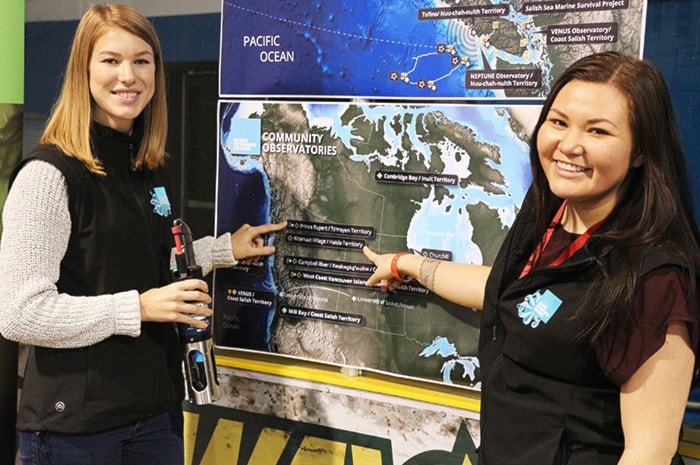The sounds of the ocean, whales and dolphins singing or the movement of massive ships coming into port will soon be available to the Prince Rupert area once two ocean monitoring systems are installed in March.
Two representatives from Ocean Networks Canada, a University of Victoria initiative, were at the All Native Basketball Tournament last week to share the details at a booth on marine technology that is coming to the area.
“So much activity is happening here,” said indigenous community liaison, Jessica Brown noting the port expansion, increased marine traffic and the potential development of liquefied natural gas terminals. “It’s important to have a baseline (of data) before things change.”
The data collected from the observatories will be accessible to the public and will offer an array of environmental and scientific information. For example, the data will improve the science involved in understanding earthquakes and underwater landslides. The observatory will also monitor ship tracking and incident responses. In addition the initiative will provide educational outreach to students in the area.
A community observatory is going to be set up on Tsimshian territory on the west side of Digby Island near the airport. It will have a shore station that will record local water quality, the sounds of marine mammals and vessels and live stream from the underwater camera. The observatory will also have an Automatic Identification System (AIS) to track vessels coming into the region as well as a Coastal Ocean Dynamics Applications (CODAR) radar system to measure surface current speed and direction.
“If there are any changes people have that data set,” Brown said. “It could influence policy and decision makers.”
A second observatory is proposed for the west side of Ridley Island. It would triangulate with the radar system on Digby Island to create surface current maps with a range of 20 to 30 km. Another device would be installed on this site to gather a higher resolution of wave heights and direction.
Ocean Networks Canada started a cable observatory off the Straight of Georgia 10 years ago and is in the process of bringing the technology further along the B.C. coast. For a year and a half representatives from the initiative have travelled to different First Nations communities to get community engagement approval for setting up an observatory in their area.
There is also an observatory proposed for Kitamaat Village, Hartley Bay, Campbell River and one along the West Coast of Vancouver Island. The City of Prince Rupert and the Port of Prince Rupert were also consulted on the design and installation.
“A web portal will be set up to provide easier access for community members. We want schools to participate in the Ocean Sense program,” said Mercedes McLean, the indigenous community learning coordinator.
The program is to connect people to the sounds and sights of the ocean to help them understand that the health of the ocean is important for the health of the planet. Teachers can use the data and resources from the community observatories to explore oceanographic instruments with students and learn more about marine science.
